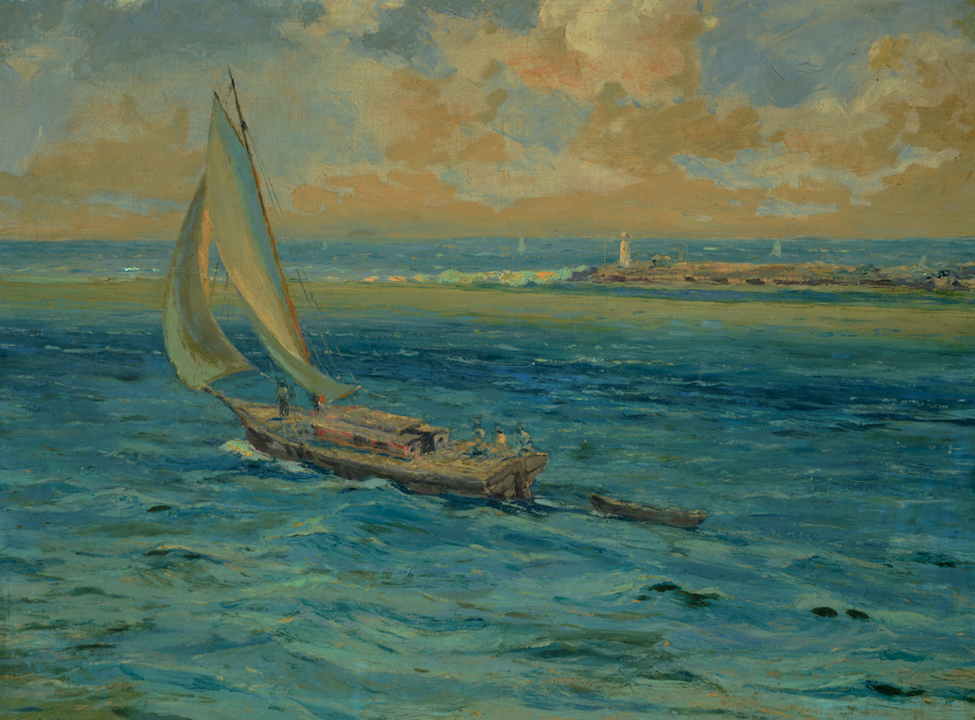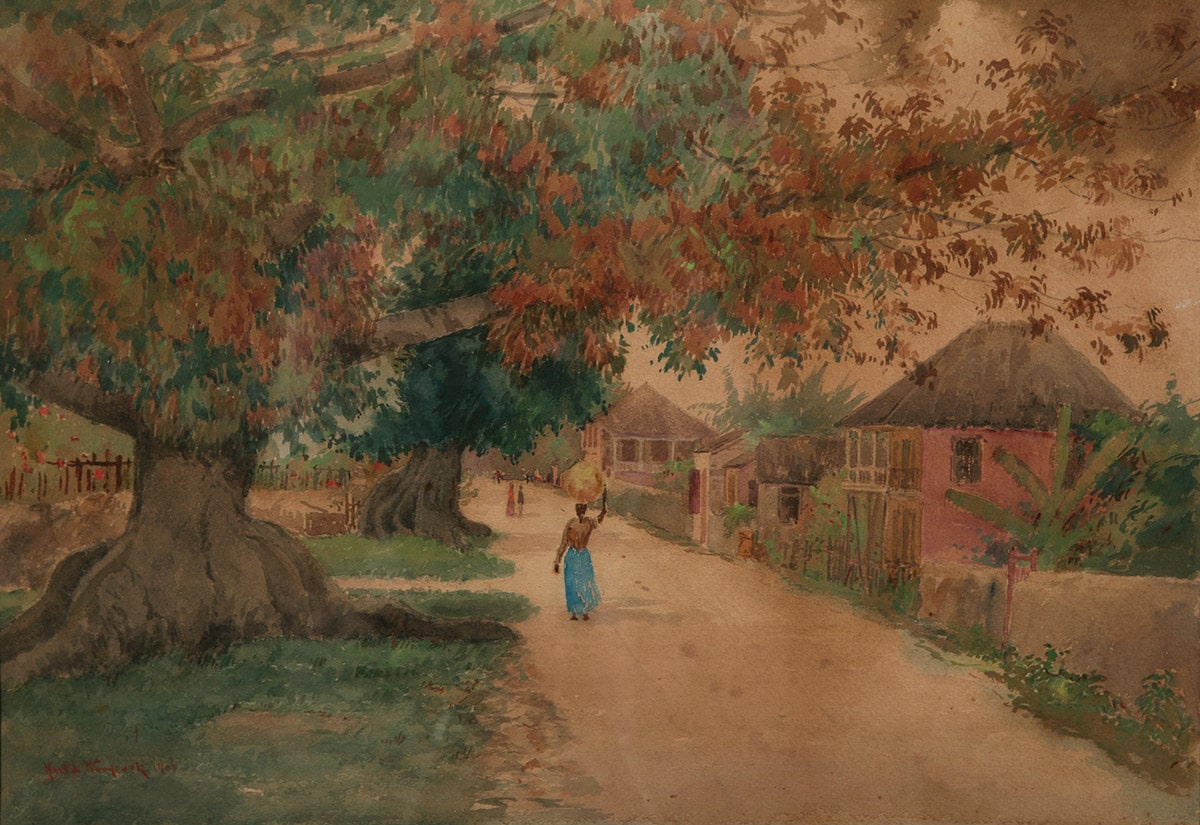
By Dr Ian Bethell-Bennett
The 1920s through the 1960s were boom time for The Bahamas, especially for Nassau and other islands like Bimini, The Berry Islands and even Grand Bahama. Along with The Bahamas experience was the Cuba experience and the Haiti experience—the Caribbean was an exotic picturesque place to go to and explore. Tourism was new, it was exciting and it was important. The offering brought diverse populations into the various tropical spaces to see and live in this milieu.

“Out to sea” (nd). E. J. Read, oil on canvas, 20 ½ x 27. Image courtesy of the Dawn Davies Collection
A great deal of this exposure came from sport. A headline in The New York Times of 8th February, 1938 reads “16 YACHTS READY FOR NASSAU RACE; Start From Miami Is Slated Today–Skipper of Stormy Weather in Doubt”. Ashley Oliphant’s Hemingway and Bimini: The Birth of Sport Fishing at “The End of the World” (2017) explores the relationship between the author and fishing in 1930s Bimini.
Thirty years on, George Symonette would be singing “Don’t touch me tomato” and the Over-the-Hill night clubs drew tourists into vibrant, hip-swinging Goombay music. Of course, Bay Street was alive and throbbing with the Colonial Hotel, the Straw Market, the Sponge Market along with the fruit market and the sloops that laid at bay, selling produce from Haiti and other islands. The exhibition currently on view at the National Art Gallery of The Bahamas, “Traversing the Picturesque: For Sentimental Value” attests to the incredible and fabulous, but also intimate and quaint life of this period. The artworks therein capture the unique way that light and colour brought together artists and sunseekers, adventurers and sports people to Nassau, Havana, Bimini, Martinique and Jamaica.
“Traversing the Picturesque: For Sentimental Value” is so utterly disarming and calming because of its quiet, unassuming richness. From impressionist work to realism of later painters, the works speak to moments in Bahamian history that have all but disappeared, both physically and mentally. Joseph Spence’s “Lay down and Take your Rest” brings back memories too, but the music that could accompany this artistic walk through historic Nassau, as much discussed in Dr. Krista Thompson’s An Eye for the Tropics (2006), brings up memories of and nostalgia for a way of life and experiences long gone.
Hildegarde Hamilton’s eye captures so much of the daily life in Nassau and has left it to attest to a time when artists and writers ‘traversed’ the Bahamian landscape, penned or brushed it into universal memories for people who might have never been able to see it in person, but could see it or hear it through the artist’s eye or the musician’s soundscapes. The Bahamian landscape and light would have attracted a great many people and in turn attracted tourists to a place that they could be at home in. They could paint, draw and write without fear. Joseph Spence’s “Brownskin Gal” also captures the time and nuances.
If the landscape attracted people to Nassau and Bimini’s “daylife,” the nightscape of bars and clubs brought them out after cocktail hour. On New Providence, the Bahamian Club would have fed and watered many a traveller and traverser of Bahamian paths; Dirty Dicks, The Pink Pussy Cat, The Cat and the Fiddle and others would have punctuated their nocturnal ramblings.
For this thought piece, I got to sit with Jay Koment, who with his stories and remembrances, excavated an entire cavern of memories for me that make this work very personal. I also took a quiet trip around “Traversing the Picturesque,” and as I walked through the show, it took me back to walking through Nassau moments that would have still been present during my life. The now car park opposite the Central Bank held a particular poignant moment that the show brought back. Also, remembering that we could drive both ways through St. Gregory’s Arch, remembering stories of Nassau and Western Esplanade or Arawak Cay from family and just how much the coastline has changed, especially here, where the Harbour has been transformed for tourism’s expansion.
Larry Smith captured it so well in “Arawak Cay and Earlier Impacts on the New Providence Shoreline” (2009)
In 1883 an act was passed to provide for the dredging of the harbour, and the following year Francisco Aranha, a civil engineer (whose great grandson is retired airline pilot Paul Aranha), was contracted to build two barges for the project. Aranha had come to The Bahamas from Brazil in 1849 to work for the Inagua Salt Company, and he was a well-known boat builder of the time.[1]
E. J Read’s work, like a street scene in Nassau, would have been far out of my personal view, except for through the artwork he left behind. However, in my life there would have remained moments that spoke to it, like low, crumbling rock walls, now all erased by time and tides of progress. Hartwell Leon Woodcock’s work also ruminates with the nostalgia of and for old Nassau. George Street lined with homes, of those old days is gone, only carcasses of buildings, in various stages of collapse remain, along with new and other kept testaments to a time long ago.

Silk Cotton Tree, Grants Town” (1906). Harwell Leon Woodcock, watercolour on paper, 10 x 14. Image courtesy of the Dawn Davies Collection
Of course, development has been sweet and bitter. Much has been gained as seen from Larry Smith’s words of the 1966 dredging of Nassau Harbour
Most of that spoil was used to create Arawak Cay, which can be considered the most significant impact in history on the state of Nassau’s coastline. At the time, the opposition Progressive Liberal Party complained bitterly about government secrecy over the project and suggested that the premier, Sir Roland Symonette, was planning to prevent public access to Saunders Beach, where he owned land.
The landscape has changed tremendously. The nostalgia for The Pipe of Peace, the Old British Airways ticket office, the City Pharmacy, the walls and doorways, the nightlife of Bay Street, can attest to a past rich in diversity and complexity. We can see the impact of filming in The Bahamas from as far back as the filmic version of Jules Verne’s 20,000 Leagues Under the Sea (1870), as pointed out to me by Koment, to Thunderball (1965).
We seem to approach history’s erasure with glib concern or flippant nonchalance. We are fortunate that the light and adventures of “Summerland” (George Northcroft, 1900) can be seen in such plentitude through the eye of artists and writers that have been held in trust by collectors and dealers such as Koment, D’Aguilar Art Foundation, Orjan and Amanda Lindroth, Jane and Anders Weiberg, Peter and Pippa Vlasov and Dawn Davies. And to the writers and historians, like Larry Smith, Paul Aranha, (my cousin, mentioned above, and my other cousin Dr. Gail North-Saunders who have worked tirelessly to capture and save so much of our story, though the physical be removed by shortsighted development goals that erase historical attractions that would draw the crowds we claim to yearn after.
We need to consider the light and seascape of our home, the night and day scapes as attractions that bring in fewer but more worthy tourists and visitors.